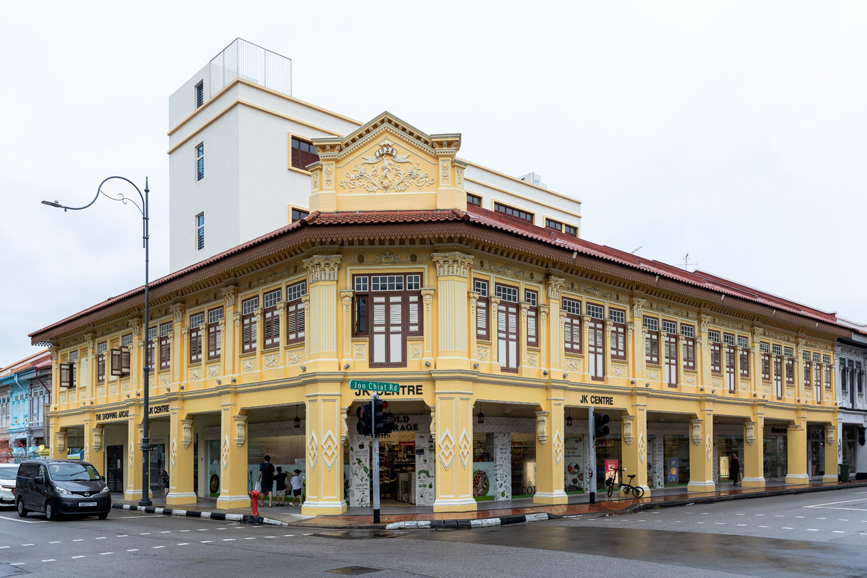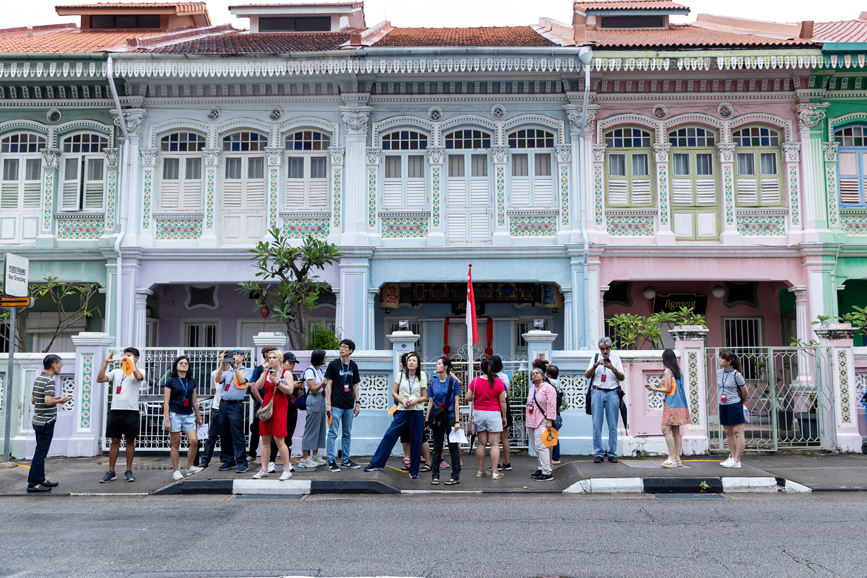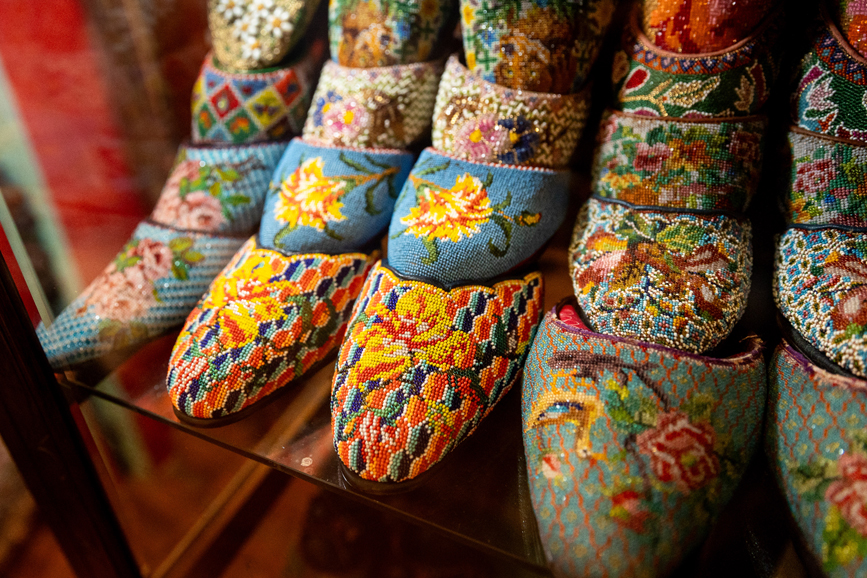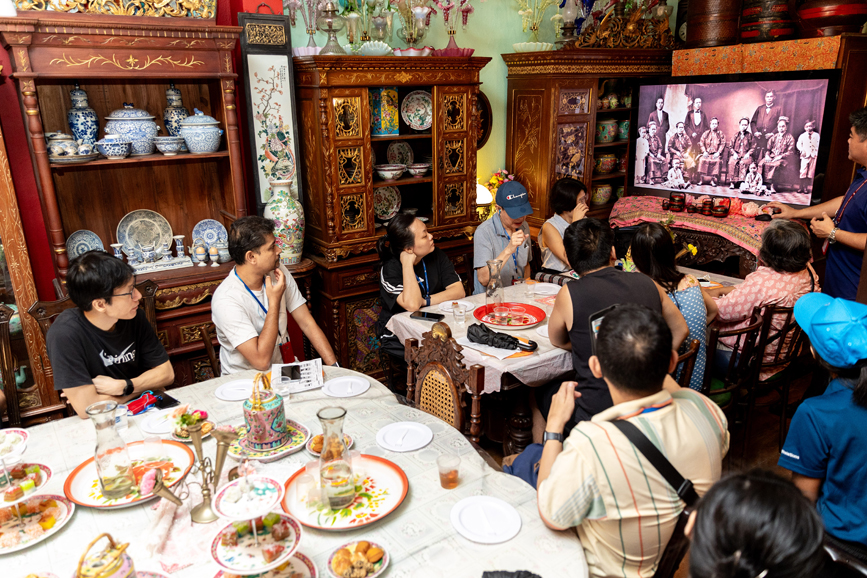5 September 2024
Unveiling Peranakan Heritage: A Journey Through Culture, Sights, and Tradition
More than 20 NUS alumni explore the rich and colourful world of Peranakan heritage, uncovering hidden gems, stunning architecture, and time-honoured traditions on this immersive cultural tour.
Event: Appreciating our Heritage: Peranakan Culture and Food Tour
Venue: Walking tour starts from Ceylon Road Interim Park (adjacent to the Eurasian Heritage Gallery/Community House at 139 Ceylon Road) and ends at Straits Enclave
Date: 24 August 2024
Meet Ms Jasmine Tan Chin Chwee (Arts & Social Sciences MA '01), a sixth-generation Peranakan who brings her deep-rooted heritage to life as a tour guide. After two decades in law and co-running a design and architecture firm with her late husband, Ms Tan’s love for culture led her to NUS for a Master of Arts degree in Southeast Asian Studies, where she studied languages, culture and religion as well as world cultures.
Ms Tan has since become a respected voice in the Peranakan community, contributing to The Peranakan magazine and co-editing the book Heritage Food of the Peranakan Indians. Since earning her license as a tour guide in 2016, Ms Tan has been passionately sharing her knowledge and love for Peranakan culture, making each tour a rich and personal experience.
Starting Point: Ceylon Road Interim Park
The tour kicked off at the serene Ceylon Road Interim Park, a charming green space adjacent to the Eurasian Heritage Gallery. This area is steeped in history, offering the 24 alumni participants the perfect backdrop to start their adventure.
Interesting food fact:
- As the group walked towards the junction of Joo Chiat Road, Ms Tan shared about Nyonya Chap Chye, a classic Peranakan dish. It’s a comforting, mixed vegetable dish with layers of flavour and texture featuring tender lily buds, earthy dried mushrooms, crispy beancurd strips, and a rich ground soya bean paste that ties everything together.
Joo Chiat Road
The next stop was a yellow shophouse along Joo Chiat Road. This building dates back to 1928 and stands as a vibrant reminder of the Peranakan community's prosperity during the early decades of the 20th century, which was largely driven by profits made through their involvement in various businesses such as running rubber plantations from the First World War. Its architectural style blends Straits Chinese and Rococo elements, reflecting the Peranakans' fondness for all things British.

Interesting sights:
- Below the year “1928” on the building is a whimsical depiction of a portly Englishman running on a ball — a character that Ms Tan shared might be adapted from a Charles Dickens novel. Some believe this figure symbolises prosperity, adding a touch of humour and charm to the building’s rich historical narrative.
- Another highlight was a shophouse which houses designer furniture firm Grafunkt. The design of this late modern style shophouse uses plenty of plaster, tile and cast iron ornamentation. Each upper-storey façade has three windows with minimal walls in between for maximum ventilation.
- A vibrant mural near Joo Chiat Road pointed to Katong’s origin. According to Ms Tan, the name "Katong" refers to a sea turtle that is now extinct. She pointed out the significance of East Coast Road, which historically marked the eastern edge of Singapore, much like how West Coast marks the western boundary, and Beach Road defines the central area.
Koon Seng Road
At Koon Seng Road, the facing rows of shophouses create a fascinating contrast in architectural styles. On one side, you'll find shophouses adorned with classic Peranakan elements — vibrant tiles and intricate floral designs that reflect the community’s rich heritage. The houses directly opposite are more reflective of Chinese traditions, featuring Taoist symbols such as deer and crabs, which are believed to bring good fortune.

Interesting fact:
-
Peranakan tiles — also known as majolica tiles — are a vibrant testament to the community's rich cultural legacy. They were commonly used in Peranakan homes from the mid-1800s to 1950s to adorn the facades and interiors. Mostly imported from Europe and Japan, these tiles were favoured by the Peranakans in Singapore and Malaysia. These colourful tiles often feature intricate designs, including floral patterns, fruits, and animals, showcasing a blend of Art Noveau and Art Deco designs, and Chinese-inspired motifs.
Interesting sight:
- A white Peranakan shophouse near Tembeling Road has a fretwork (a decorative design) that diverts rain from the five-foot way and provides shelter when it rains. According to Ms Tan, this shophouse also preserved the rare Madras glass (a type of pressed glass) that Peranakans used, which allows light to filter into the shophouse while providing privacy to the occupants.
Straits Enclave
The tour’s final stop was Straits Enclave, a private museum established four years ago to promote Peranakan culture. Here, the group was warmly welcomed by our host, Mr Clarence Chia, a fourth-generation Peranakan and a licensed tourist guide. Mr Chia is a passionate collector of Peranakan antiques, some of which have been in his family for generations.
At Straits Enclave, you can join a four-month workshop that teaches the traditional craft of making beaded Peranakan shoes. Some workshop participants have even made shoes for their weddings. As Mr Chia shared, back in the old days, Peranakans believed that a young woman’s beaded shoes could reveal a lot about her character. Matchmakers and the groom's family would examine her work to see if she was patient, meticulous and good at planning — qualities highly valued in a bride.

Interesting facts:
- As we enjoyed traditional Nyonya kueh like ondeh ondeh and tapioca cake, Mr Chia gave an insightful presentation on the origins of the Straits-born communities, introducing us to key historical figures with Peranakan ties. He spoke about Mr Gan Eng Seng, who was a champion of education and founded the Anglo-Chinese Free School in 1885 for underprivileged children. The school was later renamed Gan Eng Seng School.
- We also learned about Mr Chew Joo Chiat, a successful businessman who made his fortune growing gambier, nutmeg and coconut. After marrying a Peranakan woman and acquiring land in Katong, he allowed a public road through his land, which eventually gave the area its name — Joo Chiat. Mr Chia also shared that former Singapore leaders like Mr Lee Kuan Yew and Mr Wee Kim Wee have Peranakan heritage, further connecting this vibrant culture to Singapore's history.

- Mr Chia also shared an interesting fact about the design of Peranakan shophouses — why they typically feature just three windows and have a narrow width. This stems from the old Dutch taxation system, which required building owners to pay more taxes if their property was wider. As for the three windows, Peranakans avoided having four because the number "4" sounds like "death" in Chinese, and opting for five windows would have meant paying higher taxes.
Interesting sights:
- Straits Enclave offers a treasure trove of fascinating sights, showcasing Peranakan history and culture. Among the highlights are porcelain dinnerware sets, intricately designed double phoenix cabinets, and a rare offering box once used for placing young papayas during ancestral worship.
- Mr Chia also proudly showed us a 150-year-old Peranakan wedding bed, adorned with phoenix decorations and fragrant sachets. The bed even has small hanging bells, which, as Mr Chia explained, were meant to alert the groom’s family if a young bride — often matched for marriage as teenagers to strengthen business ties — tried to run away on her wedding night.
By the tour’s end, participants had a richer and more in-depth understanding and appreciation of Peranakan heritage and culture. From the cuisine and artforms to the stories behind historical figures and the beautiful architecture that lined our journey, each stop offered a deeper appreciation of this unique and vibrant community.
Text by Audrina Gan. Photos by Roy Yap.